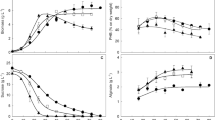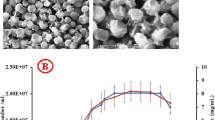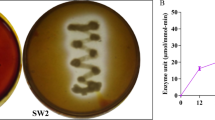Abstract
Medium and culture conditions for alginate lyase production by marine Vibrio sp. QY102 were first optimized using statistical methods including Plackett–Burman design and central composite design. Then, fermentation in 5-L bioreactor showed that alginate acted as easily used carbohydrate for Vibrio sp. QY102, while starch extended its growth phase and stabilized pH variations. Thus, a novel strategy using mixed carbon sources was proposed that starch supported growth while enzyme synthesis was induced by pulse feedings of solid alginate. The optimized process followed that Vibrio sp. QY102 grew on starch until the end of the logarithmic growth phase, and then solid alginate was added as 1 g/L every 3 h. Meanwhile, initial pH 5.0 and natural pH during fermentation was favorable for alginate lyase production. After optimization, the highest alginate lyase production reached 52.8 U/mL, which was 329 % higher than the control. Finally, fermentation scale-up was performed in 30-L bioreactor and the maximum alginate lyase production was obtained as 46.8 U/mL.






Similar content being viewed by others
References
Haug A, Larsen B, Smidsrød O (1974) Uronic acid sequence in alginate from different sources. Carbohyd Res 32:217–225
Østgaard K (1992) Enzymatic microassay for the determination and characterization of alginates. Carbohyd Polym 19:51–59
Boyen C, Kloareg B, Polne-Fuller M, Gibor A (1990) Preparation of alginate lyases from marine molluscs for protoplast isolation in brown algae. Phycologia 29:173–181
Boyen C, Bertheau Y, Barbeyron T, Kloareg B (1990) Preparation of guluronate lyase from Pseudomonas alginovora for protoplast isolation in Laminaria. Enzyme Microbiol Technol 12:885–890
YonemotoY Murata K, Kimura A, Yamaguchi H, Okayama K (1991) Bacterial alginate lyase: characterization of alginate lyase-producing bacteria and purification of the enzyme. J Ferment Bioeng 72:152–157
Gacesa P, Wusteman FS (1990) Plate assay for simultaneous detection of alginate lyases and determination of substrate specificity. Appl Environ Microbiol 56:2265–2267
Natsume M, Kamo Y, Hirayama M (1994) Isolation and characterization of alginate-derived oligosaccharides with root growth-promoting activities. Carbohyd Res 258:187–197
Kawada A, Hiura N, Shiraiwa M, Tajima S, Hiruma M, Hara K, Ishibashi A, Takahara H (1997) Stimulation of human keratinocyte growth by alginate oligosaccharides, a possible co-factor for epidermal growth factor in cell culture. FEBS Lett 408:43–46
Iwamoto M, Kurachi M, Nakashima T, Kim D, Yamaguchi K, Oda T, Iwamoto Y, Muramatsu T (2005) Structure-activity relationship of alginate oligosaccharides in the induction of cytokine production from RAW264.7 cells. FEBS Lett 579:4423–4429
Alkawash MA, Soothill JS, Schiller NL (2006) Alginate lyase enhances antibiotic killing of mucoid Pseudomonas aeruginosa in biofilms. APMIS 114:131–138
Sawabe T, Ezura Y, Kimnra T (1993) Application of an alginate lyase from Alteromonas sp. for isolation of protoplasts from a brown algae Laminaria japonica. Nippon Suisan Gakk 54:705–709
Sawabe T, Takahashi H, Ezura Y, Gacesa P (2001) Cloning, sequence analysis and expression of Pseudoalteromonas elyakovii IAM 14594 gene (alyPEEC) encoding the extracellular alginate lyase. Carbohyd Res 335:11–21
Iwamoto Y, Iriyama K, Osatomi K, Oda T, Muramatsu T (2002) Primary structure and chemical modification of some amino acid residues of bifunctional alginate lyase from a marine bacterium Pseudoalteromonas sp. strain No. 272. J Protein Chem 21:455–463
Iwamoto Y, Hidaka H, Oda T, Muramatsu T (2003) A study of tryptophan fluorescence quenching of bifunctional alginate lyase from a marine bacterium Pseudoalteromonas sp. strain No. 272 by acrylamide. Biosci Biotechnol Biochem 67:1990–1992
Aasen IM, Folkvord K, Levine DW (1992) Development of a process for large-scale chromatographic purification of an alginate from Klebsiella pneumoniae. Appl Microbiol Biotechnol 37:55–60
Ostgaard K, Knutsen SH, Dryset N, Aasen IM (1993) Production and characterization of guluronate lyase from Klebsiella pneumoniae for application in seaweed biotechnology. Enzyme Microb Technol 15:756–763
Dyrset N, Lystad KQ, Levine DW (1994) Development of a fermentation process for production of an alginate G-lyase from Klebsiella pneumoniae. Appl Microbiol Biotechnol 41:523–530
Li J, Yu W, Han F, Han W, Song K (2003) Purification and characterization of a novel alginate lyase from marine Vibrio sp.QY102. Acta Microbiol Sinica 43:753–757
Montgomery DC (1991) Design and analysis of experiments. John Wiley and Sons, New York
Gao X, Qiao SY, Lu WQ (2009) Determination of an economical medium for growth of Lactobacillus fermentum using response surface methodology. Lett Appl Microbiol 49:556–561
Cai MH, Zhou XS, Sun XQ, Tao KJ, Zhang YX (2009) Statistical optimization of medium composition for aspergiolide A production by marine-derived fungus Aspergillus glaucus. J Ind Microbiol Biotechnol 36:381–389
Wu CFJ, Hamada M (2000) Experiments: planning, analysis, and parameter design optimization. Wiley, New York
Li JS, Ma CQ, Ma YH, Li Y, Zhou W, Xu P (2007) Medium optimization by combination of response surface methodology and desirability function: an application in glutamine production. Appl Microbiol Biotechnol 74:563–571
Raunkjaer K, Nielsen PH, Hvitved-Jacobsen T (1994) Measurement of pools of protein, carbohydrate and lipid in domestic wastewater. Water Res 28:251–262
Knutson CA, Jeanes A (1968) A new modification of the carbazole analysis: application to heteropolysaccharides. Anal Biochem 24:470–481
Takase R, Ochiai A, Mikami B, Hashimoto W, Murata K (2010) Molecular identification of unsaturated uronate reductase prerequisite for alginate metabolism in Sphingomonas sp. A1. Biochim Biophys Acta 1804:1925–1936
Shi XC, Gong QH, Cheng RB (2008) Detection of the key enzyme of alginate biosynthesis in Vibrio sp. QY102. World J Microbiol Biotechnol 24:1613–1615
Murata K, Kawai S, Mikami B, Hashimoto W (2008) Superchannel of bacteria: biological significance and bew horizons. Biosci Biotechnol Biochem 72:265–277
Hashimoto W, He J, Wada Y, Nankai H, Mikami B, Murata K (2005) Proteomics-based identification of outer-membrane proteins responsible for import of macromolecules in Sphingomonas sp. A1: alginate-binding flagellin on the cell surface. Biochemistry 44:13783–13794
Miller MB, Bassler BL (2001) Quorum sensing in bacteria. Ann Rev Microbiol 55:165–199
Waters CM, Bassler BL (2005) Quorum sensing: cell-to-cell communication in bacteria. Ann Rev Cell Dev Biol 21:319–346
Acknowledgments
This work was financially supported by the Chinese National High Technology Research and Development Program (No. 2011AA090702, 2012AA092103, 2012AA092105). We thank Prof. Wengong Yu, Ocean University of China for supply of the strain.
Author information
Authors and Affiliations
Corresponding author
Electronic supplementary material
Below is the link to the electronic supplementary material.
Rights and permissions
About this article
Cite this article
Zhou, J., Cai, M., Jiang, T. et al. Mixed carbon source control strategy for enhancing alginate lyase production by marine Vibrio sp. QY102. Bioprocess Biosyst Eng 37, 575–584 (2014). https://doi.org/10.1007/s00449-013-1024-1
Received:
Accepted:
Published:
Issue Date:
DOI: https://doi.org/10.1007/s00449-013-1024-1




